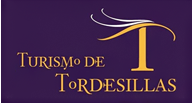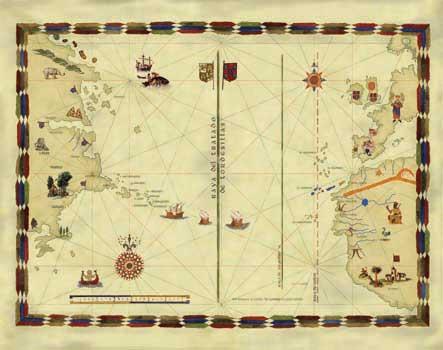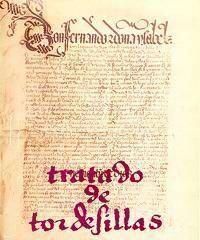The precedent to the Treaty of Tordesillas was the Treaty of Alcaçovas that was signed by the Portuguese and Castilian Crowns in 1479. The above-mentioned Treaty put an end to the succession war caused after the king Henry IV died by the succession to the Castilian throne between Isabel la Católica and Juana la Beltraneja. Besides, it gave out navigation rights and the Atlantic Ocean conquest. According to this Treaty, the Castilian kingdom, as well as Canary Islands would be for Isabel and Fernando, whereas Madeira, Porto Santo, Azores and Cape Verde Islands, as well as conquest rights of Fez kingdom and navigation rights to the south of Canary Islands parallel would be for Portugal.
Constantly, many incidents endanger the peace achieved in Alcaçovas. Multiple incidents put constant in danger the peace obtained in Alcaçovas. Problems intensify when Juan II of Portugal, after receiving Cristobal Colón in Valparaíso, in 1493, when he returned from his first travel victoriously, warns him that if the territories he had just discovered, were situated to the south of the parallel of Canary Islands, they would belong to Portugal as stipulated in Alcaçovas Treaty.
The conflict had broken out between both powers. The portuguese kingdom tried the parallel of Canary Islands served as border for both kingdoms' conquests. Catholic Monarchs reject this aim and they try Juan II took África and leave new Castilian territories for Castilian kingdom. This attempt carried out by Castilian monarchs is specified in the three rumours' enactment (1493) made by Pope Alejandro VI: "I Inter Caeteras" stablishes that all territories Colón discovered and the ones to be discovered in future will be for Castile; "II Inter Caeteras", it is altered the meaning of the first one and it is set a 100 leagues line to the west of Azores and Cape Verde that marks maritime and terrestrial control of Castile; " Eximiae devotiones" The second one is not mentioned at all and what is shown in the first one, is ratified. At the same time, the dominions assigned to castilian people are increased.
The strength Juan II showed when he rejected these solutions as well as both kingdoms' sincere wish not to begin again a new war together with the Catholic Monarchs' uncertainty to Ocean secrets and the threat made by Carlos VIII of France against the Pope, caused a large group of contacts and negotiations carried out in 1494 in Tordesillas.


